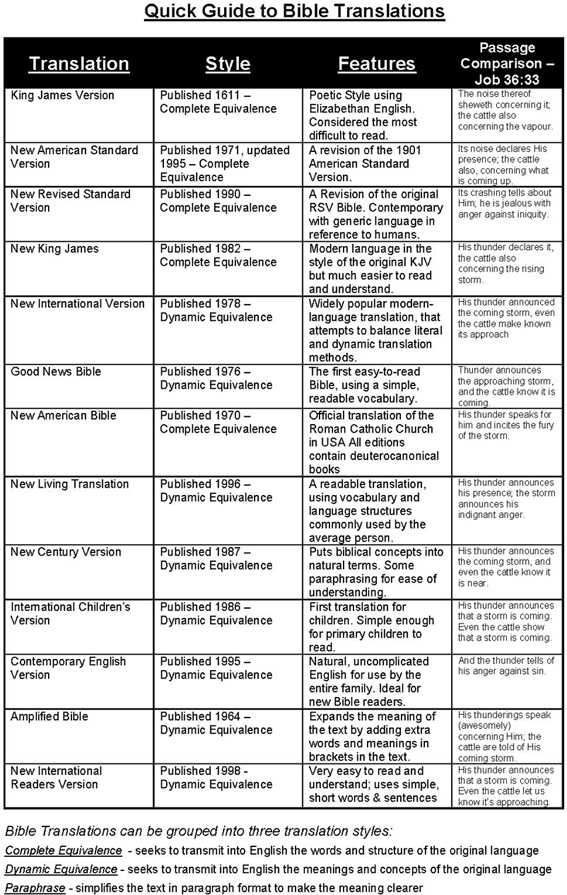

At the same period the Czechs have their own vernacular Bible, subsequently much improved by John Huss.
#Different bible versions full
John Wycliffe and his followers produce full English versions of the Old and New Testament in the late 14th century. But in the following century the same demand surfaces within mainstream western Christianity. The suppression of the Cathars is complete by the mid-13th century. The strongest medieval demand for vernacular texts comes in France from a heretical sect, the Cathars. Any such impulse is now a radical demand on behalf of ordinary Christians against the church hierarchy. In the later fully Christian centuries there is no equivalent need to provide the holy texts in vernacular form. These are missionary endeavours, promoted by rulers as an act of government when pagan Europe is being brought into the Christian fold. In the 9th century the Greek brothers Cyril and Methodius, sent from Constantinople to Moravia at royal request, translate the Gospels and parts of the Old Testament into Slavonic. In the late 8th century Charlemagne commissions translation of parts of the Bible for the use of his missionaries in the drive to convert pagan Germans. Translation into vulgar tongues is discouraged. They prefer to corner the source of Christian truth, keeping for themselves the privilege of interpreting it for the people. The text of Jerome's Vulgate is understood only by the learned, most of whom are priests. After the collapse of the western empire, the people of Christian Europe speak varieties of German, French, Anglo-Saxon, Italian or Spanish. 'Ignorance of the scriptures', he wrote, 'is ignorance of Christ'. The intention of St Jerome, translating into Latin the Hebrew of the Old Testament and the Greek of the New Testament, was that ordinary Christians of the Roman empire should be able to read the word of God. It is not known how much he completes, but large sections of the Gospels and the Epistles survive in his version - dating from several years before Jerome begins work on his Latin text.Ī restricted Bible: 8th - 14th century AD He needs the alphabet for his translation of the Bible from Greek into the language of the Goths. He even devises a new alphabet to capture accurately the sounds of spoken Gothic, using a total of twenty-seven letters adapted from examples in the Greek and Roman alphabets. Ulfilas is the first man known to have undertaken an extraordinarily difficult intellectual task - writing down, from scratch, a language which is as yet purely oral. This eventually becomes established as the Bible of the whole western church until the Reformation.īy the time the Vulgate is complete (in about 405), the barbarian Goths also have their own version of parts of the Bible - thanks to the astonishing missionary effort of Ulfilas. In his monastery at Bethlehem, tended by aristocratic virgins, the saint produces the Vulgate. In 382 the pope, Damasus, commissions Jerome to provide a definitive Latin version. These versions become corrupted and others are added, until by the 4th century - in the words of St Jerome, the leading biblical scholar of the time - there are 'almost as many texts as manuscripts'.

By the second century there is one such version in use in north Africa and another in Italy. One of them is the text of a scroll which he has himself discovered in a jar in the valley of the Jordan - exactly as with the Dead Sea Scrolls in our own time.ĭuring the 1st century Greek remains the language of the small Christian community, but with the spread of the faith through the Roman empire a Latin version of the Bible texts is needed in western regions. When it comes to the Psalms, Origen adds a further two versions. The first column is the original Hebrew next comes a transliteration of this in Greek letters, so that Christians can pronounce the Hebrew text this is followed by the Septuagint, and then by Greek translations by Christian scholars. In his Hexapla (from the Greek word for 'sixfold') Origen arranges six versions of the Old Testament in parallel columns for comparative study. Their need prompts the great work of biblical scholarship undertaken by Origen in the 3rd century AD. It is essential for their arguments, when debating with Jewish rabbis, that they have an accurate understanding of the original Hebrew. They undertake the translation of the Old Testament now known as the Septuagint.įive centuries later the early Christians, who use Greek for their own New Testament, need to read both Old and New Testaments - for they see themselves as the inheritors of the Old Testament tradition. For the Jews of Alexandria, in the 3rd century BC, Greek is the first language.

There is no need for any part of the Bible to be translated until a community of Jews, in the Diaspora, forget their Hebrew.


 0 kommentar(er)
0 kommentar(er)
